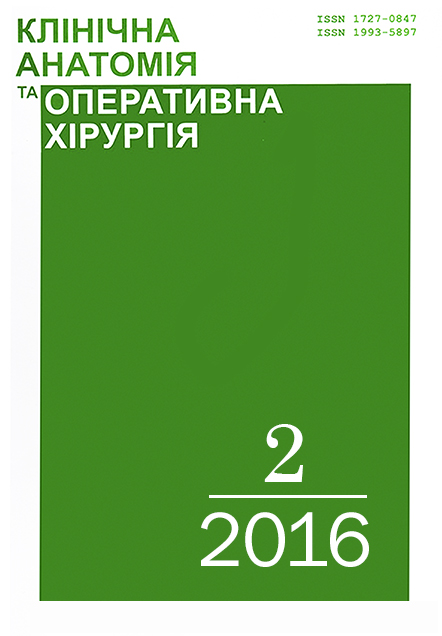ОРГАНОЗБЕРІГАЛЬНІ ОПЕРАЦІЇ З ПРИВОДУ РАКУ МОЛОЧНОЇ ЗАЛОЗИ
DOI:
https://doi.org/10.24061/1727-0847.15.2.2016.54Ключові слова:
рак, молочна залоза, органозберігальні операції, хірургічні країАнотація
Представлений огляд літератури з проблем оцінки адекватності хірургічних країв за умов органозберігальних операцій з приводу раку молочної залози. Дозволені хірургічні краї шириною 1,0-2,0 мм при забарвленні поверхні препаратом. Одностайної думки щодо показань до проведення реексцизій немає.Посилання
Azu M, Abrahamse P, Katz SJ. What is an adequate margin for breast-conserving surgery? Surgeon Attitudes and Correlates. Ann. Surg. Oncol. 2010;17:558-563.
Blair SL, Thompson K, Rococco J. Attaining negative margins in breast conservation operations: Is there a consensus among breast surgeons? J. Am. Coll. Surg. 2009;209:608-613.
McCahill LE, Single RM, Aiello EJ. Bowles Variability in reexcision following breast conservation surgery. JAMA. 2012;307:467-475.
Schwartz GF, Veronesi U, Clough KB. Proceedings of the consensus conference on breast conservation. Cancer. 2006;107:365-373.
Houssami N, Macaskill P, Marinovich ML. Metaanalysis of the impact of surgical margins on local recurrence in women with early-stage invasive breast cancer treated with breast conserving surgery. Eur. J. Cancer. 2010;6:3219-3232.
Dunne C, Burke JP, Morrow M. Effect of margin status on local recurrence after breast conservation and radiation therapy for ductal carcinoma in situ. J. Clin. Oncol. 2009;27:1615-1620.
Morrow M, Katz SJ. The challenge of developing quality measures for breast cancer surgery. JAMA. 2012;307:509-510.
Wapnir IL, Dignam JJ, Fisher B. Long-term outcomes of invasive ipsilateral breast tumor recurrences after lumpectomy in NSABP B-17 and B-24 randomized clinical trials for DCIS. J. Natl. Cancer Inst. 2011;103:478-488.
Atkins J, Al Mushawah F, Appleton CM. Positive margin rates following breast-conserving surgery for stage I-III breast cancer: palpable versus nonpalpable tumors. J. Surg. Res. 2012;177:109-115.
McGhan LJ, McKeever SC, Pockaj BA. Radioactive seed localization for nonpalpable breast lesions: review of 1,000 consecutive procedures at a single institution. Ann. Surg. Oncol. 2011;18:3096-3101.
Jeevan R, Cromwell DA, Trivella M. Reoperation rates after breast conserving surgery for breast cancer among women in England: retrospective study of hospital episode statistics. BMJ. 2012;345:4505.
Tot T. The role of large format histopathology in assessing subgross morphological prognostic parameters: a single institution report of 1000 consecutive breast cancer cases. Int. J. Breast. Cancer. 2012;2012:395-415.
Singletary SE. Surgical margins in patients with early-stage breast cancer treated with breast conservation therapy. Am. J. Surg. 2002;184:383-393.
Taghian A, Mohiuddin M, Jagsi R. Current perceptions regarding surgical margin status after breast-conserving therapy: results of a survey. Ann. Surg. 2005;241:629-639.
Caruso F, Ferrara M, Castiglione G. Therapeutic mammaplasties: full local control of breast cancer in one surgical stage with frozen section. Eur. J. Surg. Oncol. 2011;37:871-875.
Guidroz JA, Larrieux G, Liao J. Sampling of secondary margins decreases the need for re-excision after partial mastectomy. Surg. 2011;150:802-809.
Chakravorty A, Shrestha AK, Sanmugalingam N. How safe is oncoplastic breast conservation? Comparative analysis with standard breast conserving surgery. Eur. J. Surg. Oncol. 2012;38:395-398.
Persing S, James TA, Mace J. Variability in the quality of pathology reporting of margin status following breast cancer surgery. Ann. Surg. Oncol. 2011;18:3061-3065.
Arentz C, Baxter K, Boneti C. Ten-year experience with hematoma-directed ultrasound-guided (HUG) breast lumpectomy. Ann. Surg. Oncol. 2010;17(suppl 3):378-383.
Margenthaler JA, Gao F, Klimberg VS. Margin index: a new method for prediction of residual disease after breast-conserving surgery. Ann. Surg. Oncol. 2010;17:2696-2701.
Fisher B, Anderson S, Bryant J. Twenty year follow-up of a randomized trial comparing total mastectomy, lumpectomy, and lumpectomy plus irradiation for the treatment of invasive breast cancer. N. Engl. J. Med. 2002;347:1233-1241.
Halasz LM, Sreedhara M, Chen YH. Improved outcomes of breast-conserving therapy for patients with ductal carcinoma in situ. Int. J. Radiat. Oncol. Biol. Phys. 2012;82:581-586.
Mamounas EP, Tang G, Fisher B. Association Between the 21-Gene Recurrence Score Assay and Risk of Locoregional Recurrence in Node-Negative, Estrogen Receptor–Positive Breast Cancer: Results From NSABP B-14 and NSABP B-20. J. Clin. Oncol. 2010;28:1677-1683.
Dignam JJ, Dukicv VM, Anderson SJ. Hazard of recurrence and adjuvant treatment effects over time in lymph node-negative breast cancer. Breast Cancer Res. Treat. 2009;116:595-602.
Del Turco MR, Ponti A, Bick U. Quality indicators in breast cancer care. Eur. J. Cancer. 2010;46:2344-2356.
Aiello Bowles EJ, Feigelson HS, Barney T. Improving quality of breast cancer surgery through development of a national breast cancer surgical outcomes (BRCASO) research database. BMC Cancer. 2012;12:136.
Mook J, Klein R, Kobbermann A. Volume of excision and cosmesis with routine cavity shave margins technique. Ann. Surg. Oncol. 2012;19:886-891.
Smith TJ, Landercasper J, Gundrum JD. Perioperative quality metrics for one step breast cancer surgery: a patient-centered approach. J. Surg. Oncol. 2010;102:34-38.
##submission.downloads##
Опубліковано
Номер
Розділ
Ліцензія
Авторське право (c) 2017 Клінічна анатомія та оперативна хірургія

Ця робота ліцензується відповідно до Creative Commons Attribution-NonCommercial 4.0 International License.
ВІДКРИТИЙ ДОСТУП
а) Автори залишають за собою право на авторство своєї роботи та передають журналу право першої публікації цієї роботи на умовах ліцензії Creative Commons Attribution License, котра дозволяє іншим особам вільно розповсюджувати опубліковану роботу з обов'язковим посиланням на авторів оригінальної роботи та першу публікацію роботи у цьому журналі.
б) Автори мають право укладати самостійні додаткові угоди щодо неексклюзивного розповсюдження роботи у тому вигляді, в якому вона була опублікована цим журналом (наприклад, розміщувати роботу в електронному сховищі установи або публікувати у складі монографії), за умови збереження посилання на першу публікацію роботи у цьому журналі.
в) Політика журналу дозволяє і заохочує розміщення авторами в мережі Інтернет (наприклад, у сховищах установ або на особистих веб-сайтах) рукопису роботи, як до подання цього рукопису до редакції, так і під час його редакційного опрацювання, оскільки це сприяє виникненню продуктивної наукової дискусії та позитивно позначається на оперативності та динаміці цитування опублікованої роботи (див. The Effect of Open Access).



